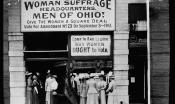text
Visual
Woman Suffrage Headquarters

This 1912 photo was taken outside the woman suffrage headquarters in Cleveland, Ohio. Far right in the photo is Miss Belle Sherwin, President, National League of Women Voters.
February 13, 2017


